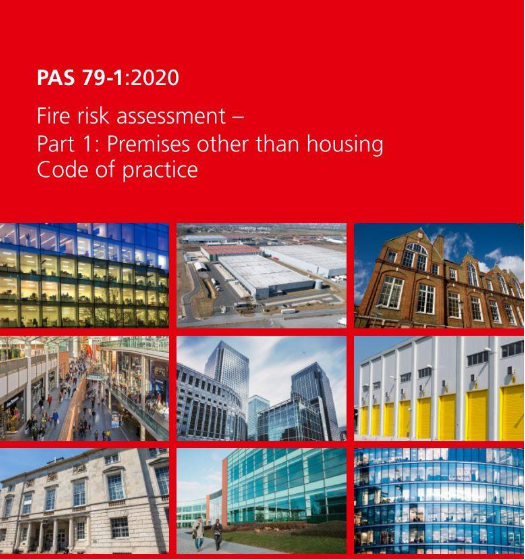New PAS 79-1:2020 and PAS 79-2:2020 code of practice for fire risk assessments

We are proud of our Principal Fire Safety Advisor, Colin Bassnett and his commitment to help drive forward improvements in fire safety. Colin contributed many hours, over a series of meetings, to join the steering group charged with reviewing PAS 79 2012.
PAS 79, which was last revised in 2012, provided generic fire risk assessment guidance. However, professionals within the housing sector were particularly keen to see more housing-specific recommendations being developed. A decision was taken to revise PAS 79, updating the existing PAS, renaming it as Part 1, and introducing a new, housing-specific Part 2.
The programme for the PAS production was set in October 2019 with a projected publication date of 7th December 2020. A target, experience demonstrated was not likely to be hit. But under the expert guidance of Sophie Watson, BSi editor, the relentless drive of Colin Todd MBE, and the enthusiastic and thoughtful contributions of the fourteen strong steering group, made up of equal representation from the Fire Safety Sector, Housing and UK F&RSs, over the course of more than 1,500 man hours, both documents were published bang on target. Quite a feat bearing in mind the 1,200 comments arising from the public consultation process, each of which had to be reviewed, considered and responded to.
The 2012 version of PAS 79 was a single document which provided generic guidance on Fire Risk Assessments for all types of properties. This has now been withdrawn and superseded by two new documents: PAS 79-1:2020 Fire Risk Assessment Part 1 – Premises Other Than Housing – Code of Practice and PAS 79-2:2020 Fire Risk Assessment Part 2 – Housing – Code of Practice.
PAS 79 Summary of key changes
PAS 79-1 and PAS 79-2 are codes of practice, whereas PAS 79:2012 was a guide. PAS 79:2012 was already written in the form of a code of practice – the change in status is simply to recognize this, noting that guides are not usually of such a nature as to sustain a reliable claim of compliance.
The following changes apply to both PAS 79-1 and PAS 79-2
- Technical content has been subject to amendment in the light of experience in the use of PAS 79.
- New guidance is included on the consideration to be given to external wall construction and cladding.
- There is recognition of pre-occupation fire safety assessments, a term now defined in PAS 79-1 and PAS 79-2 It provides clarification to avoid confusion between these assessments and the fire risk assessments to which the updated PAS 79 refers.
- Greater emphasis is placed on the competence of fire risk assessors and future competence standards. It notes that fire safety specialists with experience only in the design of new buildings might not possess an appreciation of standards against which older buildings were designed and the possible continued acceptability of such standards
- It considers changes to, and the publication of various new, British Standards.
PAS 79-1:2020 - Key changes
PAS 79-1:2020 gives recommendations on how to carry out fire risk assessments that will protect the occupants of non-domestic premises, e.g. employees, contractors, visitors and members of the public
The revision introduces the following principal change:
The scope now excludes blocks of flats, sheltered housing, extra care housing, supported housing and certain houses in multiple occupation (i.e. those falling within the scope of the relevant fire safety legislation), all of which are now covered in PAS 79-2:2020
PAS 79-2:2020 - Key changes
PAS 79-2:2020 gives recommendations and corresponding examples of documentation for undertaking, and recording the significant findings of, fire risk assessments in housing premises and parts of housing premises for which fire risk assessments are required by legislation.
It also gives recommendations for fire risk assessments that are outside the scope of fire safety legislation but are designed to protect residents of blocks of flats, sheltered housing and extra care housing in the event of a fire in their own flat.
The following points summarise the key changes.
- The scope of this new Part 2 of PAS 79 comprises blocks of flats, sheltered housing, extra care housing, supported housing and certain houses in multiple occupation (i.e. those falling within the scope of the relevant fire safety legislation).
- Guidance, published in England by the Local Government Association, on fire safety in purpose-built blocks of flats has been considered, along with equivalent guidance for high-rise blocks of flats published in Scotland by the Scottish Government
- Guidance produced by the National Fire Chiefs Council on fire safety in specialised housing has been considered, along with equivalent guidance published in Scotland by the Scottish Government
- For blocks of flats, sheltered housing and extra care housing, recommendations are provided for Types 2, 3 and 4 fire risk assessments, as defined in the Local Government Association guidance and the National Fire Chiefs Council guidance. However, for these housing premises, this PAS is primarily concerned with the Type 1 fire risk assessment required for compliance with the relevant fire safety legislation in England and Wales
- There is new, more detailed discussion of the stay put strategy normally adopted in blocks of flats and maisonettes, and this term, as well as the converse strategy of simultaneous evacuation, is now defined in this PAS
- A warning is included in respect of the potential risk to residents if a stay put strategy is inappropriately abandoned
- Reference is made to evacuation alert systems for use by the fire and rescue service in blocks of flats and maisonettes, which are the subject of BS 8629
- Reference is made to person-centred fire risk assessments in specialized housing, though specific recommendations in relation to these fire risk assessments are outside the scope of this PAS
If you would like more information regarding the implications of PAS 79 and how this will impact fire risk assessments conducted at your properties please get in touch.

